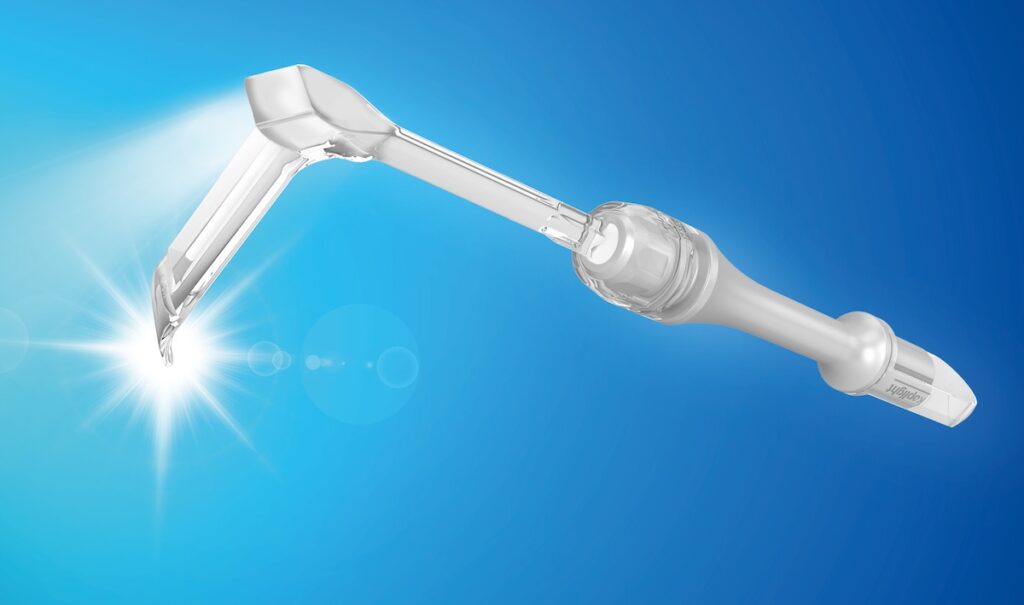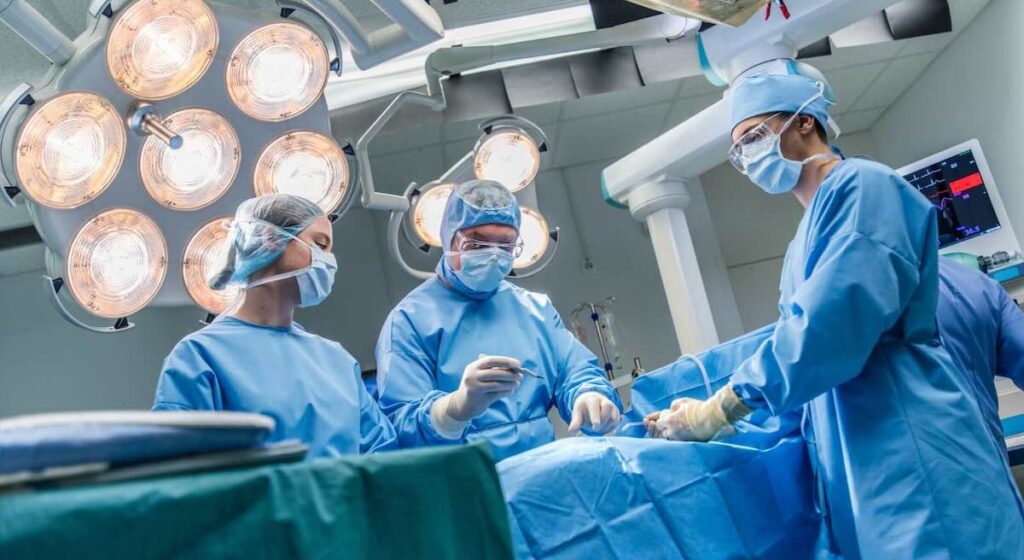Inadequately sterilizing and maintaining surgical lighting equipment can be expensive in the long run, and it can compromise patient safety. Servicing overhead lighting systems, for example, often requires third-party technicians, with rates starting at US$400 per hour, excluding parts.
This article explores best practices for cleaning and maintaining surgical lighting systems, including fixed overhead lights, fiber-optic systems, and handheld lighted devices. Using these practices will improve equipment longevity, give you optimal performance, and maintain sterile environments in the OR.
Contents
Types of surgical lighting and components
Operating rooms rely on multiple sources to provide illumination during surgeries. These sources are generally in one of three main categories:
- Ceiling-mounted overhead light systems
- Fiber-optic lighting systems
- Handheld and wearable devices
Ceiling-mounted surgical light systems are the main illumination sources in most operating rooms. They typically use LED bulbs, which have better energy efficiency, reduced heat generation, and a longer life than halogen bulbs. They also have adjustable suspension arms, handles, control panels, and specialized lenses that can minimize shadows. Overhead lights require routine checks and cleaning before and after surgery.
Fiber-optic lighting systems are secondary illumination sources for deep cavity visualization during minimally invasive surgery. These systems comprise a high-intensity light source (often xenon- or LED-based) and fiber-optic cables transmitting the light. They typically need to undergo manual cleaning followed by gas or steam sterilization.
Handheld and wearable lighted devices provide targeted illumination. They include lighted retractors, headlamps, and specialized instruments with integrated light sources. These devices often have reusable and disposable components.
Cleaning protocols for fixed overhead surgical lighting
Ceiling-mounted surgical lights are designed to last a long time. However, inadequate cleaning can impair their function and sterility.
A study from the American Journal of Infection Control found that the illuminating glass surfaces of overhead lights can be important sources of contamination and infection in the operating room. To prevent the cross-contamination of overhead lights, the authors acknowledged that hospitals need to follow specific guidelines from device manufacturers and institutions such as the Association of periOperative Registered Nurses (AORN) and Association for the Advancement of Medical Instrumentation (AAMI).
The AORN Environmental Cleaning guide recommends damp-dusting all horizontal surfaces in the operating room, including surgical lights, from top to bottom. In this regard, a low-linting cloth moistened with a hospital-grade disinfectant, such as quaternary ammonium, hypochlorite, or accelerated hydrogen peroxide, provides effective disinfection while minimizing the risk of lens damage. Before cleaning, the lighting unit should be turned off and cooled down.
Ceiling-mounted light systems typically have handles that the surgeons use to reposition the lights during surgery. The US Food and Drug Administration (FDA) categorizes these handles as “clinical contact surfaces”, meaning they’re frequently touched areas. Contact with the handles may contaminate them with blood or other potentially infectious material that can subsequently contaminate instruments, hands, gloves, or other devices.
The handle can be sterilizable or disposable. Device manufacturers recommend checking the sterilizable handle for signs of cracks, deformation, discoloration, or peeling before reprocessing it. Disposable handles should also be damage-free prior to use. They should be discarded after surgery.
Sterilizing fiber-optic and light cable systems
Fiber-optic lights and light systems are vulnerable to high temperatures and moisture. Many can’t withstand prolonged autoclaving or steam sterilization, a process that uses high or low pressures or temperatures to sterilize medical devices. According to manufacturer guidelines, steam sterilization should only apply in cases where absolutely necessary.
Fiber-optic lights need manual cleaning followed by low-temperature gas sterilization with ethylene oxide or steam sterilization. Cleaning should begin with a lint-free cloth to remove debris. Effective cleaning agents include alcohol, a mild soap, or a non-oil cleaner with a pH of 5 to 9. Synthetic detergents, oil-based soaps, or abrasive substances are not preferred as they may cause tissue reactions and device damage. After cleaning and rinsing the devices with distilled water, the medical staff can air dry or re-sterilize them.
Fiber-optic cables should undergo routine checks for any damage before use. Any damage to the fibers within the cable may reduce light transmission and compromise illumination. Damage to fiber-optic lights can be avoided and lifespans can be extended using practices such as:
- Keeping foreign materials away
- Not pulling, stretching, or kinking the cable
- Not contacting with sharp edges
- Letting the cable to slowly cool after sterilization (instead of using cold liquids)
Handling and sterilizing/disposing of handheld lighted retractors
Handheld illuminated devices, such as lighted retractors, often incorporate reusable and disposable components. These are sterilized or disposed of following the manufacturer’s guidelines.
Lighted retractors can hold tissues from the surgical field while simultaneously providing illumination using integrated light. This light is either battery-powered or connected to a light source via a cord.
Lighted retractors need a high degree of decontamination and sterilization after use. This is the only way to ensure that any potentially infectious materials don’t spread from one patient to another. The reusable retractor handles made of stainless steel or high-grade polymers are autoclavable. This means they’re thoroughly cleaned with enzymatic detergents followed by steam sterilization. Disposable blades or tips should be removed prior to sterilization of the handle and discarded as medical waste.
An incomplete sterilization process of reusable parts can lead to biofilm formation and contamination. In a cost-analysis study, Kumar et al. reported that an average of 5% of steam-sterilized instruments and 3% of plasma sterilization instruments did not meet the quality control indicators for effective sterilization.

When using rechargeable battery-powered devices, the operating room staff should pay special attention to battery maintenance. The staff should remove any batteries from lighted retractors before sterilization, where applicable. The Emergency Care Research Institute recommends implementing a system where batteries are regularly cycled through use to prevent fire hazards and ensure power delivery during procedures.
Preventive maintenance and inspection routines
Healthcare institutions are responsible for routinely checking the state of the lighting equipment in their operating rooms. A structured maintenance schedule of surgical lights is mandatory to prevent equipment errors during procedures. International guidelines, such as the International Electrotechnical Commission 60601-2-41 standard, and manufacturer manuals determine good practices for inspecting surgical lights.
Maintenance checks can be daily, monthly, or yearly. Daily visual checks typically assess lighting units’ cleanliness, alignment, and function. The operating room staff must verify that the light sources are free from visible deformation or damage and that all joints of overhead systems move smoothly. The sterilizable handle should be damage-free, disinfected, and sterilized.
Monthly and yearly inspections, however, often include verifying the integrity of suspension systems and electrical wiring. The technical personnel perform checks for material wear, corrosion, paint damage, and mechanical integrity of the support system. Long-term maintenance also involves electrical safety testing and fuse inspection. Additionally, torque testing of articulating arms ensures that lights remain properly positioned throughout surgeries.
These measures are only effective when implemented correctly and consistently. They reduce the risk of malfunction and help extend the lifespan of lighting devices.
Damage risks in cleaning, and how to avoid them
Improper cleaning and maintenance procedures can compromise surgical lighting systems, risking lighting quality and patient safety.
Scratched or cloudy lenses can reduce visibility during procedures. Manufacturers recommend avoiding abrasive cloths that create tiny scratches on optical surfaces. Similarly, high-alkaline cleaners can chemically damage lens coatings, causing permanent fogging. Low-lint cloths and pH-neutral cleaning solutions are good alternatives.
Control panels and adjustment knobs are particularly vulnerable to chemical damage. Alcohol-based cleaners can make plastic components brittle and prone to cracking. The cleaning personnel must always check compatibility charts before applying any cleaner to these surfaces.
Water damage is a common but preventable problem. Manufacturers recommend not submerging components that are not specifically rated as waterproof. They also advise against shortcuts like using cold water to speed up sterilization, as this can cause device deformation.
Heat and moisture pose special risks to fiber-optic components. Fibers that carry light can deteriorate when exposed to high temperatures during sterilization.
Physical handling matters, too. Using too much force when cleaning light heads or arms can misalign them. The cleaning personnel should understandably avoid using the lights themselves as handles during the cleaning process.
To avoid these risks, the medical and technical staff must correctly follow the manufacturer’s instructions and consult technical documentation before performing cleaning or maintenance checks.
Additional sources
- https://www.photonic.at/wp-content/uploads/2021/09/Installation-and-Service-Manual-ATO-ML-Series.pdf
- http://www.frankshospitalworkshop.com/teaching_learning/chris/CM%20surgical%20lamp%20pp.pdf.
- https://www1.eere.energy.gov/buildings/publications/pdfs/alliances/surgical_task_fs.pdf
- https://www.getinge.com/dam/hospital/documents/english/guide_maquet-surgical-lights_ultimate-guide-en-global.pdf
- https://www.medline.com/media/mkt/pdf/Retractors-IFU.pdf
- https://pediatria.gob.mx/archivos/burbuja/8_Limpieza_y_desinfeccion_del_quirofano.pdf
- https://amblersurgical.com/media//wysiwyg/Fiberoptic_Cable_Usage_and_Sterilization.pdf
- https://www.fiberopticstech.com/wp-content/uploads/2023/01/QSF-241-FTI-Medical-Light-Guide-IFU-English-Cleaned.pdf

